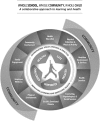The Whole School, Whole Community, Whole Child model: a new approach for improving educational attainment and healthy development for students
- PMID: 26440815
- PMCID: PMC4606766
- DOI: 10.1111/josh.12310
The Whole School, Whole Community, Whole Child model: a new approach for improving educational attainment and healthy development for students
Abstract
Background: The Whole Child approach and the coordinated school health (CSH) approach both address the physical and emotional needs of students. However, a unified approach acceptable to both the health and education communities is needed to assure that students are healthy and ready to learn.
Methods: During spring 2013, the ASCD (formerly known as the Association for Supervision and Curriculum Development) and the US Centers for Disease Control and Prevention (CDC) convened experts from the field of education and health to discuss lessons learned from implementation of the CSH and Whole Child approaches and to explore the development of a new model that would incorporate the knowledge gained through implementation to date.
Results: As a result of multiple discussions and review, the Whole School, Whole Community, Whole Child (WSCC) approach was developed. The WSCC approach builds upon the traditional CSH model and ASCD's Whole Child approach to learning and promotes greater alignment between health and educational outcomes.
Conclusion: By focusing on children and youth as students, addressing critical education and health outcomes, organizing collaborative actions and initiatives that support students, and strongly engaging community resources, the WSCC approach offers important opportunities that will improve educational attainment and healthy development for students.
Keywords: coordinated school health; health and academics; school health; whole child.
© 2015 The Authors. Journal of School Health published by Wiley Periodicals, Inc. on behalf of American School Health Association.
Figures
References
-
- Allensworth DD, Kolbe LJ. The comprehensive school health program: exploring an expanded concept. J Sch Health. 1987;57(19):409–412. - PubMed
-
- Association for Supervision and Curriculum Development (ASCD). The Learning Compact Redefined: A Call to Action. Alexandria, VA: ASCD; 2007. Available at: http://www.ascd.org/ASCD/pdf/Whole%20Child/WCC%20Learning%20Compact.pdf. Accessed January 27, 2015.
-
- ASCD, Centers for Disease Control and Prevention (CDC). Whole School, Whole Community, Whole Child: A Collaborative Approach to Learning and Health. Alexandria, VA: ASCD; 2014. Available at: http://www.ascd.org/ASCD/pdf/siteASCD/publications/wholechild/wscc-a-col.... Accessed February 6, 2015.
-
- Centers for Disease Control and Prevention (CDC). Components of coordinated school health. 2015. Available at: http://www.cdc.gov/healthyyouth/cshp/components.htm. Accessed January 27, 2015.
-
- Centers for Disease Control and Prevention (CDC). Workplace health model. 2013. Available at: http://www.cdc.gov/workplacehealthpromotion/model/index.html. Accessed February 7, 2015.
MeSH terms
LinkOut - more resources
Full Text Sources
Other Literature Sources
Medical
Research Materials


